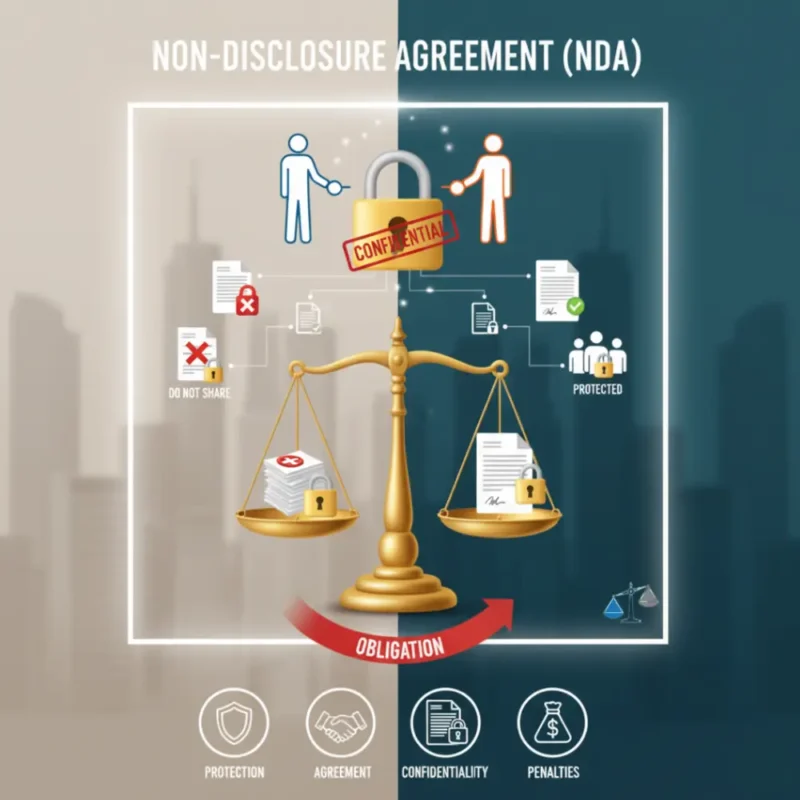Non-Disclosure Agreement (NDA): Definition & Meaning

- Non-Disclosure Agreement (NDA): Definition & Meaning
- Introduction
- Legal Definition of a Non-Disclosure Agreement
- Core Legal Meaning
- Typical Scenarios Where NDAs Apply
- Example Definition (Plain English)
- Quick Reference Table
- Essential Elements of an NDA
- Parties Involved
- Definition of Confidential Information
- Scope and Purpose
- Duration of Obligation
- Remedies for Breach
- Checklist for Drafting NDAs
- Types of NDAs
- Unilateral NDA
- Bilateral (Mutual) NDA
- Multilateral NDA
- Comparison Table
- Practical Insight
- Importance of NDAs in Business and Employment
- Protecting Business Secrets
- Building Trust in Partnerships
- Safeguarding Employer–Employee Relationships
- Encouraging Innovation
- Reducing Legal Risks
- Practical Benefits of NDAs
- Common Clauses Found in NDAs
- 1. Definition of Confidential Information
- 2. Non-Use of Information
- 3. Non-Disclosure Obligation
- 4. Term and Duration
- 5. Return or Destruction of Materials
- 6. Remedies for Breach
- 7. Exclusions from Confidentiality
- Sample Structure of NDA Clauses
- Limitations and Exceptions to NDAs
- Legal Limitations
- Recognized Exceptions
- Real-World Examples
- Quick View: Limitations vs. Exceptions
- Enforcement of NDAs in Court
- Legal Remedies Available
- Case Law Examples
- Enforcement Challenges
- Quick Reference
- NDAs in International and Cross-Border Contracts
- Key Challenges in Cross-Border NDAs
- Practical Examples
- Best Practices for International NDAs
- Summary Table
- NDAs in the Digital Age
- Electronic Execution of NDAs
- Data Protection and Cybersecurity
- Online Confidentiality Agreements
- Risks Unique to Digital NDAs
- Practical Safeguards for Digital NDAs
- Quick Reference
- Risks of Poorly Drafted NDAs
- Ambiguous Language
- Overly Broad Scope
- Unreasonable Duration
- Missing Remedies for Breach
- Failure to Address Digital Risks
- Real-World Example
- Checklist: Avoiding NDA Pitfalls
- Best Practices for Drafting an NDA
- 1. Use Clear and Precise Language
- 2. Define the Purpose of Disclosure
- 3. Keep Duration Reasonable
- 4. Address Digital and Remote Work Risks
- 5. Specify Remedies and Enforcement
- 6. Include Standard Exclusions
- Drafting Checklist
- Example Closing Clause
- Conclusion
- FAQs About Non-Disclosure Agreements
- What is the main purpose of an NDA?
- Are NDAs legally enforceable?
- How long does an NDA last?
- What happens if someone breaks an NDA?
- Can NDAs be used with employees?
- Are NDAs valid internationally?
- What information is not covered by an NDA?
- Can an NDA stop whistleblowing?
- Do NDAs work in digital contracts?
Introduction
In today’s business world, protecting sensitive information is just as important as making profits or securing clients. Companies, startups, and even individuals often rely on Non-Disclosure Agreements (NDAs) to safeguard trade secrets, intellectual property, and confidential business strategies. Without these agreements, the risk of unauthorized disclosure could damage competitiveness, reputation, or financial stability.
At its core, an NDA is a legal contract designed to ensure that private information remains private. It outlines what information must be kept confidential, who can access it, and what happens if the agreement is breached. NDAs are commonly used in business negotiations, employment relationships, joint ventures, and technology development.
The principle is simple: if one party shares valuable information, the other promises not to disclose it to outsiders or use it for personal gain. But the application is complex, involving legal rules, enforceability, and exceptions that vary across industries and jurisdictions.
This article explores the legal definition of NDAs, their essential elements, types, and role in modern business. We will also review common clauses, enforcement in courts, and best practices for drafting effective agreements. By the end, you will understand why NDAs are described as the backbone of corporate confidentiality.
Legal Definition of a Non-Disclosure Agreement
A Non-Disclosure Agreement (NDA) is a legally binding contract that establishes a confidential relationship between parties. Its primary purpose is to ensure that sensitive information shared during business, employment, or negotiation processes is not disclosed to third parties without authorization. Courts typically recognize NDAs as enforceable so long as they are reasonable in scope, duration, and subject matter.
Core Legal Meaning
- Confidentiality Obligation: The receiving party agrees not to disclose or misuse the information provided.
- Consideration: As with any contract, there must be an exchange of value—such as access to information, employment, or business opportunity.
- Enforceability: The NDA must meet general contract requirements, including offer, acceptance, and mutual assent.
Typical Scenarios Where NDAs Apply
- Employment Contracts – Protecting company secrets when onboarding new employees.
- Business Negotiations – Ensuring sensitive financial or strategic data remains confidential during mergers, acquisitions, or partnerships.
- Intellectual Property Protection – Safeguarding formulas, designs, or prototypes shared with third parties like manufacturers or developers.
- Investor Relations – Providing potential investors access to financials while preventing disclosure to competitors.
Example Definition (Plain English)
An NDA is a written agreement in which one or more parties promise not to share specific confidential information with others. It creates a legal duty to maintain secrecy and limits the use of that information strictly to the purpose for which it was shared.
Quick Reference Table
| Aspect | Legal Requirement | Example |
|---|---|---|
| Confidentiality | Information must be kept private | Employee cannot share trade secrets |
| Consideration | Exchange of value required | Access to job opportunity |
| Enforceability | Must meet contract law standards | Offer + acceptance + intent |
“An NDA is not just a promise of secrecy—it is a legally enforceable safeguard of trust.”
Essential Elements of an NDA

Every enforceable NDA shares a few core elements that define its scope and strength. If these parts are missing, the contract may be too vague to protect sensitive information effectively.
Parties Involved
The agreement must clearly identify who is sharing the information (disclosing party) and who is receiving it (receiving party). In some cases, both sides exchange confidential information, making them mutual parties.
Definition of Confidential Information
The contract must spell out exactly what counts as “confidential.” Without this definition, disputes may arise over whether certain data falls within the NDA. Common categories include:
- Business strategies and marketing plans
- Technical data, blueprints, or prototypes
- Financial information such as revenue, costs, and forecasts
- Client lists and supplier relationships
Scope and Purpose
The NDA should define why the information is being shared and how it can be used. For example, an NDA signed during merger talks might state that shared data can only be used to evaluate the transaction—not for competing business activities.
Duration of Obligation
Confidentiality is not indefinite unless explicitly stated. Courts often require that NDAs specify a timeframe, such as two, three, or five years. In cases involving trade secrets, the obligation may last as long as the information remains secret.
Remedies for Breach
The agreement should outline consequences if the NDA is violated. These may include:
- Monetary damages for losses incurred.
- Injunctions preventing further disclosure.
- Return or destruction of disclosed materials.
Checklist for Drafting NDAs
- Identify all parties clearly.
- Define “confidential information” in precise terms.
- Limit the purpose of disclosure.
- State how long confidentiality obligations last.
- Provide remedies for breach.
“An NDA without clear elements is like a lock without a key—easy to break and hard to enforce.”
Types of NDAs
Not all confidentiality agreements look the same. Depending on the situation and the number of parties involved, NDAs are structured differently. Understanding these variations helps businesses and individuals choose the right form of protection.
Unilateral NDA
- Definition: Only one party discloses confidential information, and the other agrees not to share or misuse it.
- Use Case: Common in employer–employee relationships, where the company shares trade secrets with staff.
- Example: A software company requiring its developers not to disclose source code.
Bilateral (Mutual) NDA
- Definition: Both parties exchange confidential information, and both agree to maintain secrecy.
- Use Case: Typical in joint ventures, partnerships, or merger negotiations.
- Example: Two tech startups collaborating on a product while protecting each other’s intellectual property.
Multilateral NDA
- Definition: Three or more parties agree to keep shared information confidential.
- Use Case: Useful in complex business projects involving multiple stakeholders.
- Example: A pharmaceutical company, a research lab, and an investor entering a development deal.
Comparison Table
| Type | Who Discloses? | Typical Use Case | Example |
|---|---|---|---|
| Unilateral | One party | Employer–employee | Protecting source code |
| Bilateral | Both parties | Partnerships, mergers | Two startups sharing IP |
| Multilateral | Three or more | Multi-party projects | Pharma, lab & investor deal |
Practical Insight
- Startups often use unilateral NDAs with employees and contractors.
- Business partnerships usually require bilateral NDAs for fairness.
- Large-scale projects with many collaborators rely on multilateral NDAs to avoid drafting several bilateral agreements.
“Choosing the right NDA type is about balancing trust with legal protection.”
Importance of NDAs in Business and Employment
Non-Disclosure Agreements are more than legal paperwork—they are tools of trust that allow businesses to share critical information without fear of losing their competitive edge. In both corporate and employment settings, NDAs play a vital role in protecting the interests of companies and individuals alike.
Protecting Business Secrets
- Trade Secrets: NDAs safeguard formulas, algorithms, customer lists, and strategies that give businesses a competitive advantage.
- Case Example: A beverage company might require partners to sign NDAs to protect its unique recipe. Without such protection, competitors could replicate the formula and erode market value.
Building Trust in Partnerships
When businesses negotiate mergers, acquisitions, or joint ventures, sensitive financial and operational data must be exchanged. NDAs create a safe framework for these disclosures, reassuring both sides that their information won’t be leaked or misused.
Safeguarding Employer–Employee Relationships
- Employers often disclose internal strategies, prototypes, or client databases to employees.
- NDAs ensure employees cannot take that information to competitors or use it for personal ventures.
- Example: An engineer leaving a tech company may be legally bound by an NDA not to disclose or replicate patented designs.
Encouraging Innovation
Startups and research labs frequently need to share groundbreaking ideas with investors or potential collaborators. NDAs encourage openness by protecting intellectual property, allowing innovators to pitch confidently.
Reducing Legal Risks
Courts often view NDAs as evidence that parties took reasonable steps to protect confidentiality. This strengthens legal claims in the event of a breach. Without an NDA, proving ownership of trade secrets becomes more difficult.
Practical Benefits of NDAs
- Secure sharing of sensitive data in negotiations.
- Legal protection for trade secrets and intellectual property.
- Clear boundaries for employees handling confidential material.
- Increased confidence for investors and business partners.
“NDAs transform fragile trust into enforceable confidence, enabling businesses to share ideas without losing them.”
Common Clauses Found in NDAs
The strength of an NDA depends on its clauses. Each provision defines the boundaries of confidentiality, the obligations of the parties, and the consequences of breach. While the exact wording may vary, certain clauses appear in almost every well-drafted NDA.
1. Definition of Confidential Information
- Purpose: Identifies what information is protected.
- Example: “Confidential information includes technical data, trade secrets, financial information, and client lists.”
- Tip: Too narrow a definition leaves gaps; too broad can make enforcement harder.
2. Non-Use of Information
- Purpose: Prevents the receiving party from using confidential data for any purpose other than the stated business objective.
- Example: An investor cannot use financial details from a startup pitch to compete against that startup.
3. Non-Disclosure Obligation
- Purpose: Prohibits sharing confidential information with unauthorized third parties.
- Example: An employee cannot provide client lists to competitors.
4. Term and Duration
- Purpose: Specifies how long confidentiality obligations last.
- Example: Two years for general information, indefinite for trade secrets.
5. Return or Destruction of Materials
- Purpose: Requires the receiving party to return or destroy documents, prototypes, or data after the business relationship ends.
- Example: A consultant returns all reports and deletes digital copies after project completion.
6. Remedies for Breach
- Purpose: Outlines what happens if the NDA is violated.
- Possible Remedies:
- Monetary damages.
- Court injunctions to stop further disclosure.
- Recovery of profits earned through misuse of confidential data.
7. Exclusions from Confidentiality
- Purpose: Clarifies what is not considered confidential.
- Common Exclusions:
- Publicly available information.
- Data independently developed by the receiving party.
- Information disclosed under legal obligation (e.g., court order).
Sample Structure of NDA Clauses
| Clause | Function | Example |
|---|---|---|
| Definition | Clarifies what is confidential | Trade secrets, technical data |
| Non-Use | Limits use of information | Investor cannot compete |
| Non-Disclosure | Prevents sharing | Employee cannot leak client list |
| Duration | Sets time limits | 2 years, indefinite for trade secrets |
| Return/Destruction | Controls materials after contract | Consultant deletes files |
| Remedies | Provides enforcement | Damages, injunctions |
| Exclusions | Lists what is not confidential | Public information |
“The real power of an NDA lies not in its existence, but in the precision of its clauses.”
Limitations and Exceptions to NDAs
While NDAs are powerful legal tools, they are not absolute. Courts often scrutinize these agreements to ensure they are fair, reasonable, and not overly restrictive. If an NDA is drafted too broadly or imposes unreasonable obligations, it risks being declared unenforceable.
Legal Limitations
- Overbreadth
- If an NDA attempts to cover information that is not truly confidential, a court may refuse enforcement.
- Example: Labeling all workplace conversations “confidential” is excessive.
- Unreasonable Duration
- Most courts reject NDAs that bind parties indefinitely for ordinary business information.
- Trade secrets may be protected longer, but general data usually has a time limit.
- Restraint of Trade
- NDAs cannot be disguised non-compete clauses. If an NDA prevents someone from working in their field, it may be struck down.
Recognized Exceptions
NDAs typically contain built-in exceptions where confidentiality does not apply. Common scenarios include:
- Public Domain: Information already available to the public cannot be retroactively made confidential.
- Independent Development: If the receiving party develops the same information independently, without using disclosed data, the NDA does not apply.
- Prior Knowledge: Information already known before signing the NDA is excluded.
- Legal Obligations: If a court or regulatory agency demands disclosure, the NDA cannot override that legal duty.
Real-World Examples
- Tech Startups: A startup’s NDA was invalidated because it attempted to prevent investors from discussing general industry trends, which are public information.
- Pharmaceutical Industry: Courts upheld exceptions allowing disclosure to regulators for drug approval, even though data was otherwise confidential.
- Employee Cases: Courts limited employer NDAs when they attempted to restrict workers from reporting illegal practices (whistleblowing).
Quick View: Limitations vs. Exceptions
| Category | Key Point | Example |
|---|---|---|
| Limitation | NDA too broad | All conversations “confidential” |
| Limitation | Unreasonable duration | 20 years for non-trade secrets |
| Exception | Public domain info | Published patents |
| Exception | Independent development | New design created separately |
| Exception | Legal obligation | Disclosure in court |
“NDAs are not meant to silence fairness, but to protect genuine confidentiality within reasonable bounds.”
Enforcement of NDAs in Court
When an NDA is breached, the injured party can take the matter to court. Enforcement depends on whether the agreement is reasonable, clearly drafted, and whether actual harm can be demonstrated. Courts typically look at the language of the contract, the conduct of the parties, and the nature of the information in dispute.
Legal Remedies Available
- Injunctions (Equitable Relief)
- Courts can order the breaching party to immediately stop disclosing or using confidential information.
- Useful when monetary damages alone would not prevent further harm.
- Monetary Damages
- Compensation for losses caused by the breach.
- May include lost profits, market share reduction, or reputational damage.
- Liquidated Damages Clauses
- Some NDAs specify a pre-agreed penalty for breach.
- Courts will enforce these only if the amount is reasonable and not punitive.
- Return/Destruction Orders
- Judges may order the return of physical documents or the deletion of digital data.
Case Law Examples
- IBM v. Papermaster (2008)
- A former IBM executive joined Apple, allegedly violating his NDA.
- Court granted an injunction preventing him from working at Apple for a set period.
- Lesson: NDAs can protect trade secrets even in employment disputes.
- PepsiCo v. Redmond (1995)
- A PepsiCo executive was prevented from working for Quaker Oats after disclosing confidential strategies.
- Court applied the “inevitable disclosure doctrine,” enforcing the NDA to prevent competitive harm.
- Silicon Valley Startup Case (Anonymous, 2019)
- An investor leaked startup pitch information to a rival.
- Court awarded damages and emphasized that investors are equally bound by NDAs.
Enforcement Challenges
- Proving Damages: It can be hard to quantify harm caused by disclosure.
- Jurisdictional Issues: Cross-border NDAs may raise enforcement challenges.
- Overly Broad NDAs: If terms are unreasonable, courts may refuse enforcement entirely.
Quick Reference
| Remedy | Application | Example |
|---|---|---|
| Injunction | Stop further breach | Court order halting leaks |
| Monetary damages | Compensate loss | Lost profits from disclosure |
| Liquidated damages | Pre-agreed penalty | $100,000 for breach |
| Return/Destruction | Remove access | Delete confidential files |
“Courts enforce NDAs not only to punish breaches, but to preserve the trust and secrecy that make business possible.”
NDAs in International and Cross-Border Contracts
When business extends across borders, NDAs become more complex. Confidentiality obligations may cross jurisdictions with different legal systems, languages, and enforcement standards. What is valid in one country may not be recognized in another, making international NDAs a unique challenge.
Key Challenges in Cross-Border NDAs
- Choice of Law and Jurisdiction
- International NDAs must specify which country’s laws govern the agreement.
- Without this, disputes can lead to costly litigation in multiple jurisdictions.
- Cultural and Legal Differences
- Some jurisdictions interpret confidentiality more strictly than others.
- For instance, U.S. courts tend to broadly enforce NDAs, while some European courts may strike down terms viewed as anti-competitive.
- Language Barriers
- Ambiguities arise if contracts are not carefully translated.
- Best practice is to prepare the NDA in both English and the local language.
- Enforcement Abroad
- Even if an NDA is valid in one country, enforcing it internationally may require cooperation under treaties or recognition by foreign courts.
Practical Examples
- Technology Transfer: A U.S. tech company licensing software to a German distributor uses an NDA with clauses under New York law, ensuring global enforceability.
- Joint Ventures: An Indian manufacturer and a UK partner draft a bilingual NDA with arbitration clauses to prevent jurisdictional conflicts.
- Pharmaceutical Research: Cross-border clinical trials use NDAs that comply with EU data protection rules (GDPR) and U.S. HIPAA standards simultaneously.
Best Practices for International NDAs
- Specify Governing Law: Always include a choice-of-law clause.
- Add Arbitration Clauses: International arbitration (e.g., ICC, UNCITRAL) avoids uncertainty in foreign courts.
- Use Clear Definitions: Define “confidential information” in a way understandable across legal systems.
- Dual Language Contracts: Avoid disputes over translation by having both parties sign copies in their own language.
Summary Table
| Issue | Risk | Solution |
|---|---|---|
| Jurisdiction | Multiple lawsuits | Choice-of-law clause |
| Cultural/legal differences | Overly strict or weak enforcement | Tailor clauses per jurisdiction |
| Language | Misinterpretation | Dual-language contract |
| Enforcement abroad | Difficult recognition | Arbitration clauses |
NDAs in the Digital Age
The rise of digital business has reshaped how confidentiality agreements are created, signed, and enforced. Sensitive information is now shared not only in boardrooms but also across email, cloud servers, and virtual platforms. NDAs have adapted to address the unique risks of the digital environment.
Electronic Execution of NDAs
- E-signatures: Courts in most jurisdictions recognize electronically signed NDAs as legally binding under laws such as the U.S. E-SIGN Act or the EU’s eIDAS Regulation.
- Click-to-Accept: Similar to clickwrap agreements, parties may agree to NDAs by ticking a box or clicking a button online.
Data Protection and Cybersecurity
- Modern NDAs often include clauses covering data privacy and security measures.
- These may reference compliance with regulations such as GDPR (Europe) or CCPA (California).
- Example: A cloud service provider’s NDA may require encrypted storage and limited access to sensitive data.
Online Confidentiality Agreements
- Increasingly, businesses use digital NDAs when granting access to online databases, research portals, or SaaS platforms.
- These contracts govern not only non-disclosure but also acceptable use of digital systems.
Risks Unique to Digital NDAs
- Data Breaches – Even with NDAs, leaked information through hacking can cause irreparable harm.
- Cloud Storage Issues – Cross-border data storage raises questions about which country’s laws apply.
- Unauthorized Sharing – Employees may disclose information unintentionally via messaging apps or unsecured emails.
Practical Safeguards for Digital NDAs
- Mandating strong encryption and password protocols.
- Restricting access to confidential documents on a “need-to-know” basis.
- Requiring immediate reporting of cybersecurity incidents.
- Including clauses about remote work and digital device usage.
Quick Reference
| Digital Concern | NDA Adaptation | Example |
|---|---|---|
| E-signatures | Legally recognized | Signing via DocuSign |
| Data privacy | GDPR/CCPA clauses | Cloud provider compliance |
| Unauthorized sharing | Restricted access | Limited employee permissions |
| Breaches | Notification obligations | 48-hour reporting rule |
“In the digital era, NDAs are not just about promises of silence, but about technical safeguards and legal compliance.”
Risks of Poorly Drafted NDAs
A poorly written NDA can create more problems than it solves. Instead of protecting sensitive information, vague or overreaching clauses may leave gaps, cause disputes, or render the agreement unenforceable. Businesses must understand these risks to avoid costly legal battles.
Ambiguous Language
- Problem: If “confidential information” is not clearly defined, parties may argue about what is covered.
- Example: An NDA that simply states “all business information is confidential” may be struck down for vagueness.
- Consequence: Courts may refuse enforcement, leaving trade secrets unprotected.
Overly Broad Scope
- Problem: Attempting to classify publicly available or trivial data as confidential.
- Example: An NDA that prohibits discussing industry trends already published in newspapers.
- Consequence: Courts may limit or invalidate the entire contract.
Unreasonable Duration
- Problem: Binding parties for decades over ordinary information.
- Example: A 25-year NDA for a marketing strategy that is only relevant for two years.
- Consequence: Courts often strike down such terms as unreasonable.
Missing Remedies for Breach
- Problem: Without clear consequences, enforcement becomes uncertain.
- Example: An NDA that fails to specify what happens if information is leaked.
- Consequence: Parties may face lengthy and expensive litigation.
Failure to Address Digital Risks
- Problem: NDAs that ignore cybersecurity and remote work realities.
- Example: Not requiring secure cloud storage or breach notification clauses.
- Consequence: Companies remain exposed to data leaks despite having an NDA.
Real-World Example
- A U.S. startup sued an investor for leaking pitch details. The NDA was dismissed because it never defined “confidential information” precisely. The startup lost both legal protection and market advantage.
Checklist: Avoiding NDA Pitfalls
- Define confidential information clearly.
- Keep the scope and duration reasonable.
- Include detailed remedies for breach.
- Address modern digital security concerns.
- Ensure compliance with relevant laws and jurisdictions.
“An NDA is only as strong as its weakest clause—draft carelessly, and it may collapse when needed most.”
Best Practices for Drafting an NDA
Drafting a strong NDA requires more than copying a template. The language must balance clarity, fairness, and enforceability while reflecting the specific needs of the parties. A well-drafted NDA not only protects confidential information but also avoids disputes by anticipating challenges.
1. Use Clear and Precise Language
- Avoid vague terms like “all business information.”
- Instead, specify categories: “technical data, prototypes, financial reports, customer databases.”
- Sample Wording: “Confidential information includes but is not limited to trade secrets, client lists, product designs, and non-public financial data.”
2. Define the Purpose of Disclosure
- Explain why the information is being shared.
- Prevents misuse beyond the intended business relationship.
- Example: “The information may only be used to evaluate a potential joint venture.”
3. Keep Duration Reasonable
- Limit confidentiality to 2–5 years for general data.
- Allow indefinite protection for trade secrets.
- Best Practice: Courts are more likely to enforce NDAs with realistic timelines.
4. Address Digital and Remote Work Risks
- Require encryption, secure cloud storage, and limited access.
- Add breach notification clauses (e.g., disclosure within 48 hours of a cyber incident).
5. Specify Remedies and Enforcement
- Include provisions for damages, injunctions, or return of materials.
- Add arbitration or jurisdiction clauses for international enforceability.
6. Include Standard Exclusions
- State that the NDA does not cover:
- Publicly available information.
- Independently developed data.
- Information disclosed under legal obligations.
Drafting Checklist
✔ Define confidential information precisely.
✔ Explain the business purpose.
✔ Set realistic duration.
✔ Include remedies and dispute resolution methods.
✔ Address cybersecurity and digital storage.
✔ Add exclusions to avoid overbreadth.
Example Closing Clause
“The parties acknowledge that unauthorized disclosure of confidential information may cause irreparable harm. Therefore, remedies may include injunctive relief, damages, and return of materials, in addition to any other remedies available under law.”
“An NDA should be a shield, not a weapon. Drafting with balance ensures both fairness and enforceability.”
Conclusion
A Non-Disclosure Agreement (NDA) is far more than a routine contract—it is the backbone of modern confidentiality. Whether in employment, partnerships, or international commerce, NDAs make it possible for businesses to share sensitive information without fear of losing competitive advantage.
From their essential elements to their various types, NDAs ensure clarity in defining what is confidential, how long it remains protected, and what happens if secrecy is breached. Courts enforce them when they are drafted with precision, fairness, and reasonable limits. But when NDAs are vague, overly broad, or silent on remedies, they can fail just when protection is most needed.
In today’s digital and globalized economy, NDAs have evolved to cover issues such as cybersecurity, data privacy, and cross-border enforcement. Businesses must therefore treat these agreements not as boilerplate documents, but as carefully tailored contracts that reflect their specific risks and goals.
Ultimately, a well-drafted NDA builds trust, encourages collaboration, and provides a legal framework that protects innovation. By following best practices—clear definitions, reasonable duration, remedies for breach, and digital safeguards—parties can ensure that their confidential information remains exactly that: confidential.
“NDAs are the silent guardians of business trust, enabling ideas to be shared without being stolen.”
FAQs About Non-Disclosure Agreements
What is the main purpose of an NDA?
The primary purpose of an NDA is to protect confidential information from being disclosed or misused. It ensures that sensitive business, technical, or financial details remain private.
Are NDAs legally enforceable?
Yes. Courts generally enforce NDAs if they are reasonable in scope, duration, and purpose. However, overly broad or vague NDAs may be struck down.
How long does an NDA last?
The duration varies:
- General business information: typically 2–5 years.
- Trade secrets: can last indefinitely, as long as the information remains secret.
What happens if someone breaks an NDA?
Breaching an NDA can result in:
- Monetary damages for financial losses.
- Injunctions stopping further disclosure.
- Return or destruction orders for confidential materials.
Can NDAs be used with employees?
Yes. Employers often use NDAs to protect trade secrets, client lists, or proprietary strategies. Courts generally enforce them as long as they don’t unfairly restrict future employment opportunities.
Are NDAs valid internationally?
They can be, but enforceability depends on the jurisdiction. For cross-border NDAs, parties should include choice-of-law and arbitration clauses to avoid conflicts.
What information is not covered by an NDA?
Typical exclusions include:
- Information already in the public domain.
- Data independently developed by the receiving party.
- Disclosures required by law or court order.
Can an NDA stop whistleblowing?
No. NDAs cannot legally prevent individuals from reporting illegal or unethical activities to regulators or law enforcement.
Do NDAs work in digital contracts?
Yes. Courts recognize e-signed NDAs and digital acceptance (click-to-agree). Many modern NDAs also include clauses on data security and breach notification.
“NDAs are only as strong as their clarity and fairness—when drafted well, they protect both innovation and trust.”





